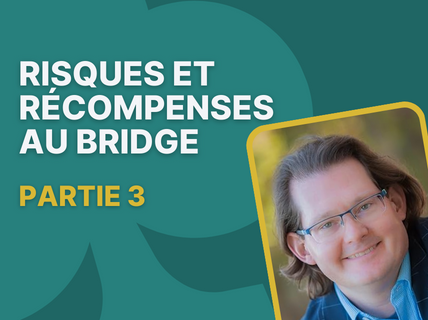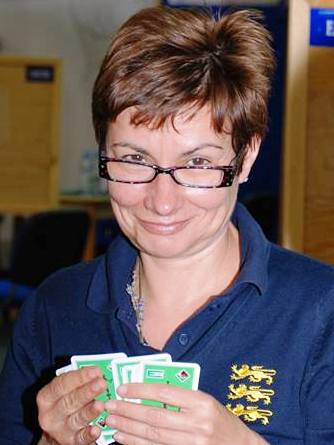


Part 1

In some parts of the world, bridge is well established with national organisations, bridge clubs and private teachers who help new players get started on their journey to learning bridge. In other places though, things are not so easy for new players. It's true, that some of us have a clearer pathway to bridge success than others. Regardless of where you sit though, there are always ways to improve, and in this article I'm going to share some ideas on how to learn and improve beyond beginner's level.
If you are on a tight budget or can't commit to set times for group lessons, you may feel that your bridge development has stalled for lack of money or time. It does not need to be so. There are lots of things you can learn on your own, even if you have a busy schedule.
To start with, unless you've studied math beyond basic level, you might struggle to understand the use of odds in both bidding and play. Get yourself a basic book or find a decent article online (it could be even one aimed at children) on probabilities and think in terms of cards when reading the examples. You may come across something like:
There are 5 balls in a draw. 4 are blue, 1 is red. One is picked blindly. What is the probability of the red one being picked? The answer is 1/5. It is calculated by dividing the number of times the event might happen (one, as there's only one red ball) by the total numbers of possible outcomes (five, as there are five balls in total). Now think of it in terms of cards.
When trying to play the above for no losers, you intend to finesse North for the Queen, as you've always been told that you should finesse when holding 8 cards between the two hands. But do you need to cash the Ace or King first? Will you check on a singleton Queen and then proceed to finesse? Cashing to start with, will succeed any time the suit is 3-2 with the Queen onside and when the Queen is on its own offside, but will fail if the singleton offside was anything but the Queen for lack of a card to finesse one more time. The direct finesse will succeed when the suit breaks 3-2 or 4-1 and the Queen is in the right place. If you think of the ♠9,♠8,♠7,♠4 as the blue balls and the ♠Q as the red one, playing to catch a singleton queen is way against the odds. Following this method would only give you a probability of succeeding one in five times - not good odds!
Next, try to improve your counting. Remember, each player holds 13 cards divided into four suits of also 13 cards each. Instead of counting by adding up each card played, try to count only your opponents cards. For example if you have 8 trumps, the defenders hold 5. Concentrate on their trumps as it is far easier to count to 5 than 13.
Bidding judgment is a lot more important than systems or conventions, if you can improve or master it. Look out for books or online materials that could help you develop a better sense of when to push or stay low or how to choose to play instead of defending in competitive auctions. Watch top level broadcasts online, especially pairs who have either a very natural approach to bidding or use a system and conventions similar to the ones in your arsenal. No point staring at a bidding sequence with lots of alerts and explanations that you struggle to understand. Yes, every so often you may see conventional bidding describing one player's precise shape, point count or honors distribution, that enables partner to bid the perfect slam on a 4-3 fit; but this is not going to improve your judgment. You may admire their system, but what you should be looking for, is the way experts employ the methods that you are familiar with. Compare their bidding with what you would have bid and if there is a mismatch, try to analyze their reasons to differ. You might discover an inference you haven't thought about before, which will be able to help you future judgment no end.
One way to improve your bidding judgement is by playing in the BBO bidders challenge - every month you have the opportunity to respond to 8 bidding problems, and at the end of the month you get to see how the team of experts tackled them. It's a good way to compare your approach to bidding with top players, across a wide variety of hands.
You can learn a lot when playing face-to face against better players. When competing in a tournament, ask yourself what your aim is. Are you trying to finish as high as possible or are you going to treat this as a learning experience and benefit from it? If it's the latter, be happy to have the opportunity to play against the top players and use it to your advantage. If they give you a bottom, don't feel disappointed, use your chance to learn. You can ask them, "Did I do something really bad and if so, how could I have done better?" or, "how did you get this hand right, when the majority of the room got it so wrong?". The majority of top players will be happy to engage in such a conversation with you. You might have been just unlucky and when they tell you so, it will make you feel better; but if you made a mistake or they took an exceptionally good decision, their explanation will help you to learn for the future. All beginners are taught for example, to lead 4th highest from their longest and strongest vs NT or to avoid leading the suit that opponents have bid. This is usually excellent advice, that works more often than not for two reasons. One, because NT contracts are usually beaten by cashing long suits rather than just high cards, and two, because your partner knows to return your suit. On the majority of deals it's a successful approach. But there are deals that require different tactics:
Following the standard advice, most West's in the room would lead a spade, declarer will win and knock out the ♣A. Even if East now finds a heart switch, dummy will hold up twice and then declarer will take the diamond finesse. Contract made, losing two hearts, ♣A and ♦K.
An expert might find a heart lead and beat your contract. Instead of "kicking" yourself, why not make the best out of it and ask something like "Great lead, how did you find it?". As long as you don't sound sarcastic you can then learn a lot about short/opponent's suits lead vs NT. The expert West will point out that during the bidding, South has shown nine cards in the minors, a solid spade stopper and at most two hearts. On the majority of deals, East will have four or five hearts and any other lead won't set the pace in the defender's favour.
If you struggle to follow the play when reading bridge books or articles, take a pack of cards, deal them reconstructing the hand in question and play them out in the way it's described. I used to do this before I learned to follow the play when using symbols instead of cards and it helped me a great deal. You can do this even when going through hands played at a tournament or a local club using the print out. It's much better than staring at a sheet and circling or ticking the cards played, as it can get very messy if you want to go back and replay.
You can also import hands into your Deal Archive folder on BBO and replay them using or not the Double dummy analysis.
All the bridge hands you have played on BBO are being stored almost forever in your History folder. You can also see the way the play went. When you have a bit of spare time, go back and see where you went wrong. The "Double dummy" tells you what every single card that was played was leading to. But remember - what you see there is not necessarily the way you should have declared or defended. It assumes you knew the whole deal and that your opponents were never going to make an error. When looking at past boards, try to work out why you played this way, was it consistent with all the info you had up to this point and if so, move on to the next example where you deviated from the "Double dummy" analysis.
And finally, Bridge Master on BBO is great. It's a free tool (that you used to have to pay for) that helps you to improve your declarer play. There are loads of hands for different levels, you can go back if you've made an error. If you exhaust your ideas on how to solve a hand, you can always fall back on the "Show solution" option, which takes you through, step by step how and why a hand should be declared.
These are just some of things that you can do to move beyond beginner level. I'm sure lots of you have other ideas too. Please go ahead and drop them in the comments below.
About the author
Nevena is a multiple World and European champion, having played for Bulgaria, Great Britain and England. She teaches bridge to all levels, both face to face and online.




How do you learn if you’re by yourself, without a partner?
there are half a dozen books that are ESSENTIAL READING e.g. "The play of the cards" by Reese/Dormer ...create that list
What are the other books you recommend ?
Watch Vugraphs! Lots of learning from great players.
Thank you, very informative. Look forward to more articles
Great tips Nevena, thanks.
However, I didn't understand the comment "I used to do this before I learned to follow the play when using symbols instead of cards and it helped me a great deal." What do you mean by "using symbols instead of cards" (to replay hands)?
I didn't know about Deal Archive, so I'll definitely have a look at that too!
Am looking forward to the next article.
sorry my reply is so long in coming ... I think she was referring to the option to display the hands in BBO Account/Settings as "Picture of Cards" When on, the hand looks like it would if you were holding 13 cards, arranged by suit. When you turn this option off, you get a display of the four suit symbols on separate lines, each followed by the cards held in that suit in rank order, as you would see in a newspaper bridge book or magazine.
Great article. Very informative and helpful.
Thank you - always useful to have someone else’s viewpoint. I look forward to further articles of advice. Caiti 3
Vert good
Excellent counting tips. Will practice using. Looking forward to future articles.
too many blanks
Great
Thanks. I'll be looking forward to next month's article.
learned a lot !
thanks
I have trouble counting trump! Love this idea of only counting the missing trump. I surely can count accurately to 5 or even 6. Thank you.
Very helpful and understandable. I learned something new in the first seconds. Thank you.
I've played basic bridge for years and want to improve but fall into the need free advice category. Thank you for the tips.
Very useful advice, not only for improvers but for any non expert player who wants to get better.
Great article! Thanks!
I liked it a lot
Very useful thanks.
Very helpful thank you
Definitely food for thought!
Well done and Nevena. A lot of useful and sensible advice. I’ll try and send the link to more people.